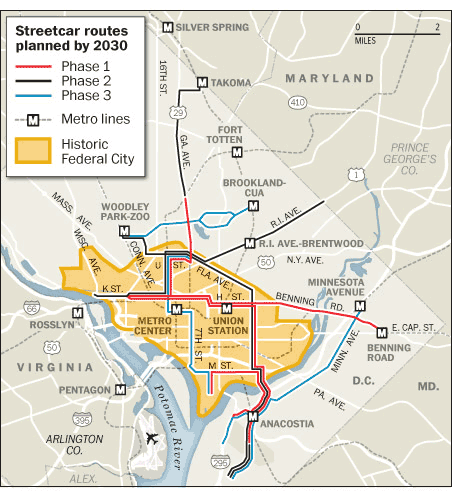Streetcar and capital planning in the Washington metropolitan area
A few months ago, Transport Politic ran a piece on streetcar planning in the Washington region, "Washington Comes Closer to Bridging the Gap with its New Streetcar Network."
Yesterday, I talked to a DDOT inspector overseeing alley and sidewalk replacement in my neighborhood, and in our wide ranging conversation about transportation planning and implementation in DC, he asked me what I thought of streetcars.
He was derisive, because the planned lines "don't go anywhere".
While I fervently support streetcars because they will significantly improve the transit experience for current riders, while also leading more people to take transit instead of drive because of the improvements in reliability, and will contribute significantly to commercial district revitalization as an augur to new investment and reinvestment, I still think the planning process is significantly flawed, as I have written in "Looking backwards vs. looking forwards, tradeoffs, constraints and urban revitalization in the 21st century city."

DC streetcars awaiting use. Washington Post photo.
Having the northern streetcar line divert to Takoma instead of going up to Silver Spring is a perfect example. But having the Michigan Avenue line truncate at Brookland Metro instead of going out to Prince George's Plaza and the University of Maryland, and having the Rhode Island line start at Rhode Island Metro and not at Dupont Circle, and truncate at the DC border in Mount Rainier, instead of going out to College Park or even Laurel is just as limited.

Graphic: Nathaniel Vaughn Kelso/The Washington Post - April 6, 2010, "D.C. streetcar project may get hung up on overhead wires."
DC needs a master transportation plan. One that recognizes and supports various objectives in an expansive fashion, and streetcar planning is a perfect example of the problems that occur when that isn't done.
But for the streetcars to have the kind of impact there needs to be, the planning would have to be more expansive, and DC would have to take the initiative and bring Montgomery County and Prince George's County Maryland into the planning process.
Yesterday's Post blog for Arlington County had an interview with the new county manager, "New manager enjoying Arlington and its people," and he discusses the streetcar project and transportation planning more generally. From the article:
As Arlington continues to increase the density around its Metro stations and throughout the county, how do you see it impacting transportation infrastructure?
Increased development with increased transit ridership has actually resulted in decreased traffic counts and congestion on streets adjacent to Metro corridors. This needs to be known and better accepted in the community. Transportation infrastructure will improve to provide more transit services and mobility options. For example, the County Board just approved a bike sharing system for Crystal City. ...
The Columbia Pike street car has been in the planning stages for quite some time. Has the Crystal City street car line moved to the front of the line with funding? What can residents in both corridors expect in the near future?
The county's six-year capital plan fully funds the Columbia Pike Streetcar and the initial phase of the Crystal City Streetcar, using a combination of funding sources.
The Columbia Pike Streetcar project is further along in the planning stages -- Arlington and Fairfax counties have begun the federal environmental process -- so it will move to construction first. Construction will likely begin in the 2013 timeframe and be completed by 2016.
As we wrap up the planning efforts for Crystal City, that streetcar line will move into the environmental phase. Right now, it is anticipated that construction will begin in the next three to four years, and also take about three years to complete. We envision both projects ultimately becoming part of a larger regional streetcar network, providing greater connectivity outside of the Metro corridors.
The Columbia Pike streetcar project is a good example of how multiple jurisdictions can plan a streetcar project jointly. While Arlington County has taken the lead, Fairfax County was brought to the table and is a co-equal partner in the project.Plus, Arlington County, like virtually every city and county jurisdiction in the United States, EXCEPT DC, also has a 6 year capital improvement planning and funding process, so that projects such as these are budgeted for, and not subject to last minute political manipulation (instead all the political manipulation is in the upfront process). See "Gray gets flak over late-night flip-flop on streetcar funds" from the Post.
The Transport Politic piece is more hopeful and believes that the DC streetcar lines will be extended over time, writing:
But the District’s project, if implemented correctly, could play an important role in the development of this newly growing metropolis. The eight lines highlighted for construction are relatively well-planned and will hit the right spots for this city.
But these lines have been seriously truncated in the current planning process. I am 50 years old and I don't expect that these errors will be adequately corrected in my professional lifetime (figure 20 more years) and maybe even beyond that. I likely will die before some of these extensions occur, if they ever do.
Streetcars in "DC" + Maryland: What could be: From Transport Politic
Labels: change-innovation-transformation, civic engagement, progressive urban political agenda, sustainable land use and resource planning, transportation planning, urban design/placemaking




0 Comments:
Post a Comment
<< Home